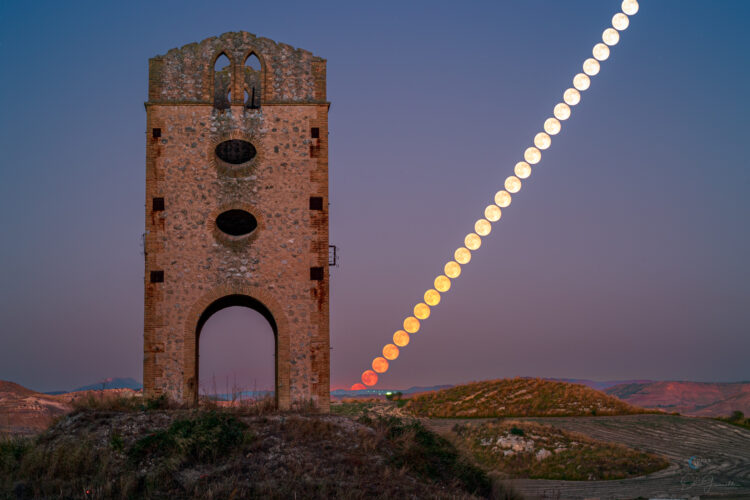The Color of Anti-Twilight
Description
From the photographer: “The photograph depicts the moon rising next to a vertical shaft, reminiscent of Pirandello’s Ciàula coming out of the Taccia Cacia Mine. The moon’s colors are red, orange, yellow, and white due to its interaction with the Earth’s atmosphere. The image evokes memories of the carusi and workers who worked underground to extract sulphur, a vital resource for the Sicilian economy between the 19th and part of the 20th century. The structure in the photograph is not a tower or fortification but the remains of a vertical shaft. The history of these mines is mostly abandoned and partially restored to memory and public use. The darkness of the mine instilled fear and suffering, but the darkness of night is a source of wonder due to the succession of extraordinary colors. On clear days, the colors in the direction of sunset and antisolar take on saturated and well-defined hues, ranging from intense blue to yellow near the horizon. Immediately after sunset, spectacular phenomena can be observed:
The Belt of Venus; A bright band of intense pink that appears above the horizon, in the opposite direction to the Sun.
The Earth’s Shadow: Just below the Belt of Venus, the shadow cast by our planet itself stands out, visible as a band of deep blue.
The Horizon Band: As the minutes pass, the blue fades into an almost neutral and opaque shade near the horizon.
The Red Band: The thin red band after the Horizon Band is a rare sight, with its physical causes unknown. The formation of the Red Band is believed to come from the diffusion of purple light during twilight.”
Technical details:
Canon 6dmod, Sigma 85mm, f/5.6, 1/125 x29, iso 400
Secondary image:
Canon 6dmod, Sigma 85mm, f/5.6, iso 100, AV Priority Mode, 92 shots in vertical stripes, time flowing from left to right, same white balance, same exposure for all shots.


comments (0)